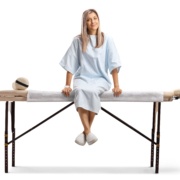Benefits of Bodywork for Breast Cancer Clients
Did you know massage therapy can alleviate anxiety in cancer patients as well as improve symptoms of cancer treatment such as pain, fatigue and immune system function? A 2009 study in The Journal of Alternative and Complementary Medicine measured anxiety, pain, nausea, sleep quality and quality of life in women undergoing treatment for breast cancer. Participants experienced a reduction in side effects from chemotherapy and radiation and had an improved perceived quality of life and overall functioning after 30 minutes of massage performed weekly for three weeks.
Manual lymph drainage (MLD), also known as Lymphatic drainage therapy (LDT) is a style of bodywork that calms the sympathetic nervous system, reduces swelling and improves immune system function. It has been shown to improve chemotherapy induced neuropathy, post-surgical swelling and scar tissue. In fact, a 2016 study in Lymphatic Research and Biology, showed self MLD combined with physical exercise was beneficial for breast cancer patients in preventing postmastectomy scar formation, upper limb lymphedema, and shoulder joint dysfunction. This study solidifies the importance of properly functioning lymphatics and empowers breast cancer clients to help themselves with recovery. Self MLD is easy to do, but it is important to first understand the how, where and when of using this technique. The way MLD is performed after lymph node removal, surgery and radiation is not the same as it would be prior to treatment.
Clients in treatment or with a cancer history benefit most by working with MTs trained in massage for oncology clients. Chemotherapy, radiation, surgery and lymph node removal have immediate as well as lifelong effects on the body that should be taken into consideration during a massage session. During cancer treatment, massage is a respite for body and mind, but therapy must be tailored to where the client is at in their treatment process. As chemotherapy progresses, cellular changes in the body result in fatigue, susceptibility to bruising and bleeding and an increased risk of infection.
The removal of lymph nodes, surgery and radiation cause damage to the lymphatic system, sometimes resulting in Lymphedema, a condition where fluid cannot properly drain from tissue causing swelling. Although Lymphedema usually occurs in the first three years following treatment, there is a lifelong risk of developing it, even years later. This is so important for two reasons. One, because onset is typically due to an event that over taxes the affected limb. Two, because Lymphedema can be reversed if treated early. This means paying attention when your affected limb feels heavy or fatigued during activity and taking a break. Avoiding things like deep tissue massage on the affected limb as well as blood pressure cuffs, shots, etc. and always contact your healthcare provider if symptoms do not go away.
Understanding the effects of cancer treatment, lymphedema risk and how to adapt massage for oncology clients is specialized training that is not typically taught in massage school. If you are going through cancer treatment or have a cancer history, always book your massage with a trained and experienced therapist.
by Aimee Kupcak
Bibliography
Cancer Council. (2021, September 25). Does Massage Spread Cancer? Retrieved from cancer.org.au: www.cancer.orgau
Sturgen, W.-H. (2009). Effects of therapeutic massage on the quality of life among patients with breast cancer during treatment. the journal of alternative and complementary medicine, 373-380.
Zhang, F. (2016, June 16). Combining Manual Lymph Drainage with Physical Exercise after Modified Radical Mastectomy. Retrieved from www.liebertpub,com: www.liebertpub.com



